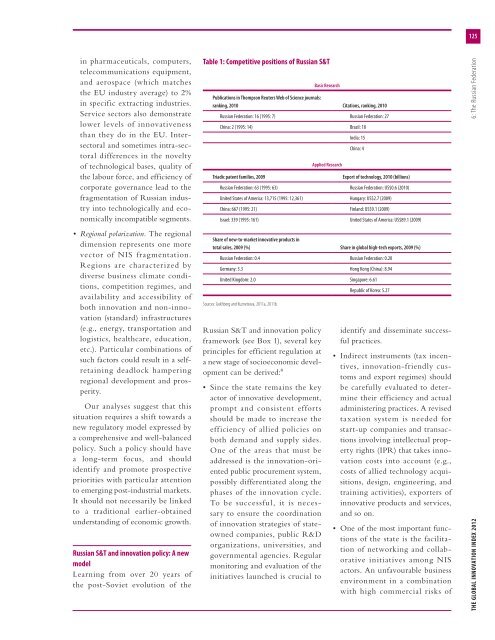The Global Innovation Index 2012
The Global Innovation Index 2012
The Global Innovation Index 2012
You also want an ePaper? Increase the reach of your titles
YUMPU automatically turns print PDFs into web optimized ePapers that Google loves.
in pharmaceuticals, computers,<br />
telecommunications equipment,<br />
and aerospace (which matches<br />
the EU industry average) to 2%<br />
in specific extracting industries.<br />
Service sectors also demonstrate<br />
lower levels of innovativeness<br />
than they do in the EU. Intersectoral<br />
and sometimes intra-sectoral<br />
differences in the novelty<br />
of technological bases, quality of<br />
the labour force, and efficiency of<br />
corporate governance lead to the<br />
fragmentation of Russian industry<br />
into technologically and economically<br />
incompatible segments.<br />
• Regional polarization. <strong>The</strong> regional<br />
dimension represents one more<br />
vector of NIS fragmentation.<br />
Regions are characterized by<br />
diverse business climate conditions,<br />
competition regimes, and<br />
availability and accessibility of<br />
both innovation and non-innovation<br />
(standard) infrastructures<br />
(e.g., energy, transportation and<br />
logistics, healthcare, education,<br />
etc.). Particular combinations of<br />
such factors could result in a selfretaining<br />
deadlock hampering<br />
regional development and prosperity.<br />
Our analyses suggest that this<br />
situation requires a shift towards a<br />
new regulatory model expressed by<br />
a comprehensive and well-balanced<br />
policy. Such a policy should have<br />
a long-term focus, and should<br />
identify and promote prospective<br />
priorities with particular attention<br />
to emerging post-industrial markets.<br />
It should not necessarily be linked<br />
to a traditional earlier-obtained<br />
understanding of economic growth.<br />
Russian S&T and innovation policy: A new<br />
model<br />
Learning from over 20 years of<br />
the post-Soviet evolution of the<br />
Table 1: Competitive positions of Russian S&T<br />
Sources: Gokhberg and Kuznetsova, 2011a, 2011b.<br />
Russian S&T and innovation policy<br />
framework (see Box 1), several key<br />
principles for efficient regulation at<br />
a new stage of socioeconomic development<br />
can be derived:8<br />
• Since the state remains the key<br />
actor of innovative development,<br />
prompt and consistent efforts<br />
should be made to increase the<br />
efficiency of allied policies on<br />
both demand and supply sides.<br />
One of the areas that must be<br />
addressed is the innovation-oriented<br />
public procurement system,<br />
possibly differentiated along the<br />
phases of the innovation cycle.<br />
To be successful, it is necessary<br />
to ensure the coordination<br />
of innovation strategies of stateowned<br />
companies, public R&D<br />
organizations, universities, and<br />
governmental agencies. Regular<br />
monitoring and evaluation of the<br />
initiatives launched is crucial to<br />
Basic research<br />
Publications in Thompson reuters Web of Science journals:<br />
ranking, 2010 Citations, ranking, 2010<br />
russian federation: 16 (1995: 7) russian federation: 27<br />
china: 2 (1995: 14) Brazil: 18<br />
India: 15<br />
china: 4<br />
Applied research<br />
Triadic patent families, 2009 Export of technology, 2010 (billions)<br />
russian federation: 63 (1995: 63) russian federation: uS$0.6 (2010)<br />
united States of America: 13,715 (1995: 12,361) Hungary: uS$2.7 (2009)<br />
china: 667 (1995: 21) finland: uS$9.1 (2009)<br />
Israel: 339 (1995: 161) united States of America: uS$89.1 (2009)<br />
Share of new-to-market innovative products in<br />
total sales, 2009 (%) Share in global high-tech exports, 2009 (%)<br />
russian federation: 0.4 russian federation: 0.20<br />
Germany: 3.3 Hong Kong (china): 8.94<br />
united Kingdom: 2.0 Singapore: 6.61<br />
republic of Korea: 5.27<br />
identify and disseminate successful<br />
practices.<br />
• Indirect instruments (tax incentives,<br />
innovation-friendly customs<br />
and export regimes) should<br />
be carefully evaluated to determine<br />
their efficiency and actual<br />
administering practices. A revised<br />
taxation system is needed for<br />
start-up companies and transactions<br />
involving intellectual property<br />
rights (IPR) that takes innovation<br />
costs into account (e.g.,<br />
costs of allied technology acquisitions,<br />
design, engineering, and<br />
training activities), exporters of<br />
innovative products and services,<br />
and so on.<br />
• One of the most important functions<br />
of the state is the facilitation<br />
of networking and collaborative<br />
initiatives among NIS<br />
actors. An unfavourable business<br />
environment in a combination<br />
with high commercial risks of<br />
125<br />
THE GLOBAL INNOVATION INDEX <strong>2012</strong> 6: <strong>The</strong> Russian Federation






